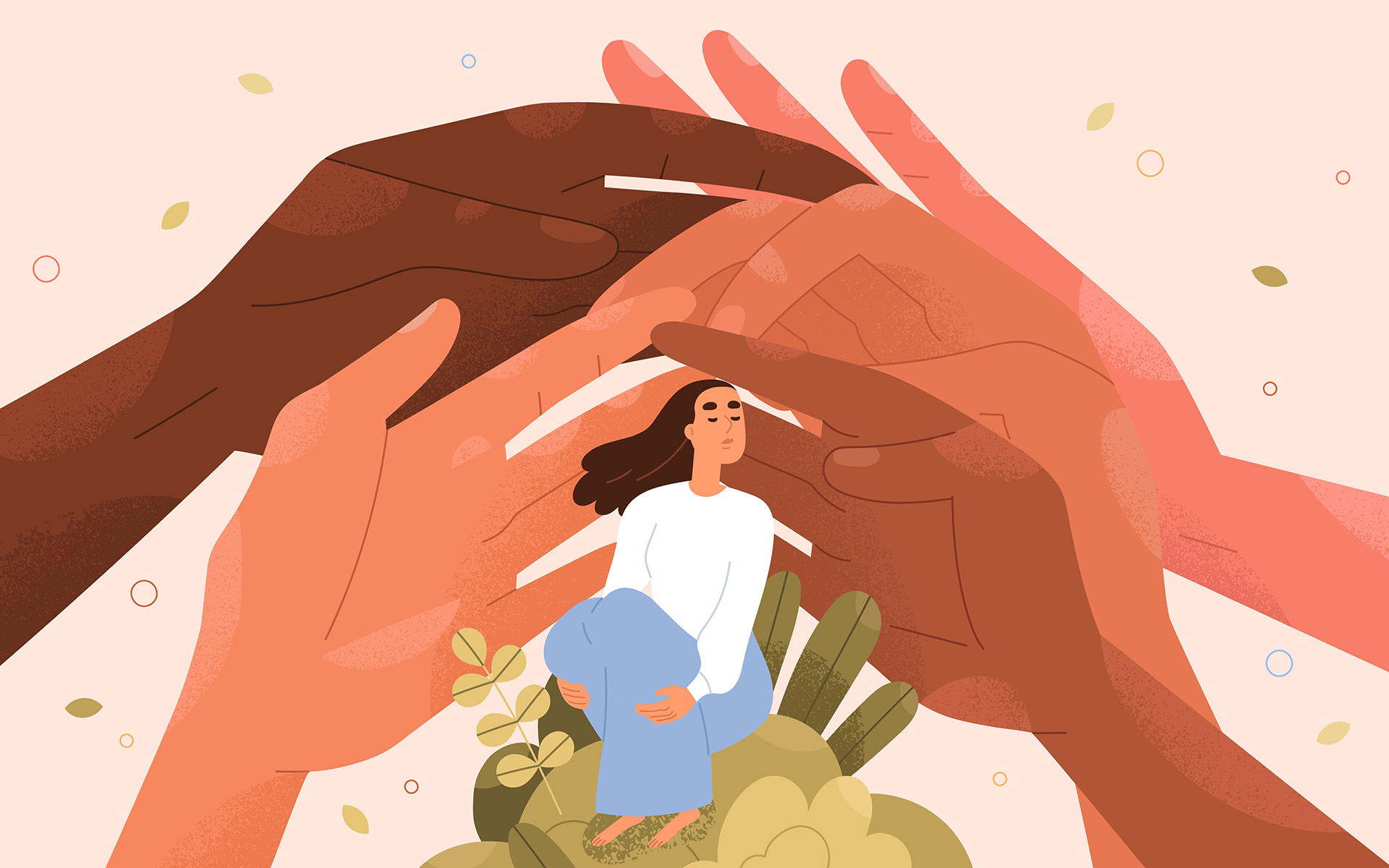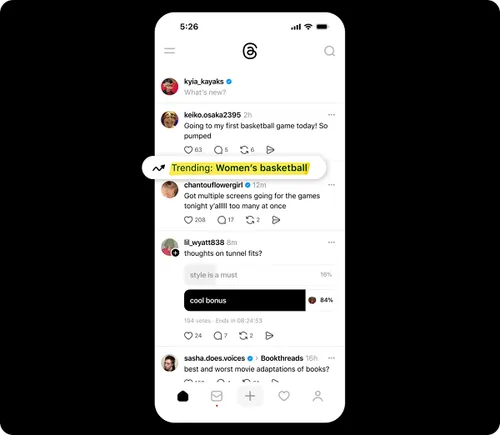Immovable Lord Achala, Fudo Myoo, ferocious activity of compassion of Maha Vairochana
Immovable Lord Achala, Fudo Myoo, ferocious activity of compassion of Maha Vairochana Why is Achala, the ferocious form of enlightenment, so popular in most schools of Mahayana Buddhism? Why is Achala the ultimate manifestation of wrathful compassionate activity? Why...

Immovable Lord Achala, Fudo Myoo, ferocious activity of compassion of Maha Vairochana
Why is Achala, the ferocious form of enlightenment, so popular in most schools of Mahayana Buddhism? Why is Achala the ultimate manifestation of wrathful compassionate activity? Why does he resemble a stern warrior or enforcing police officer with weapons drawn?

Fudo Myoo in Japan
In Japan, we visualize Achala, or Fudo Myoo, as the wrathful soldier form. He is the same deity as Vairochana Buddha, a wrathful emanation of the Buddha of Light. He is prominent in the Maha Vairochana Sutra and is also described with his symbolism in the Aryachala Sutra:
At that time, there was a great wisdom king in the vast assembly of Vairocana.
This great wisdom king possesses unlimited majestic power,
Having the virtue of great compassion, he appears in a blue-black form.
Having the virtue of great stillness, he sits on an adamantine rock.
Having great wisdom, he manifests great flames.
He wields the great sword of wisdom to destroy greed, ignorance, and hatred.
He holds the snare of samādhi to bind those hard to tame.
Because he is the formless Dharmakaya identical with space, he has no fixed abode;
his only dwelling is within the hearts of sentient beings.
Although the minds and inclinations of sentient beings differ,
by each one’s desires, he bestows blessings and provides whatever is being sought.
At that time, the great assembly, having heard this sūtra, rejoiced greatly, faithfully accepted it, and put it into practice.
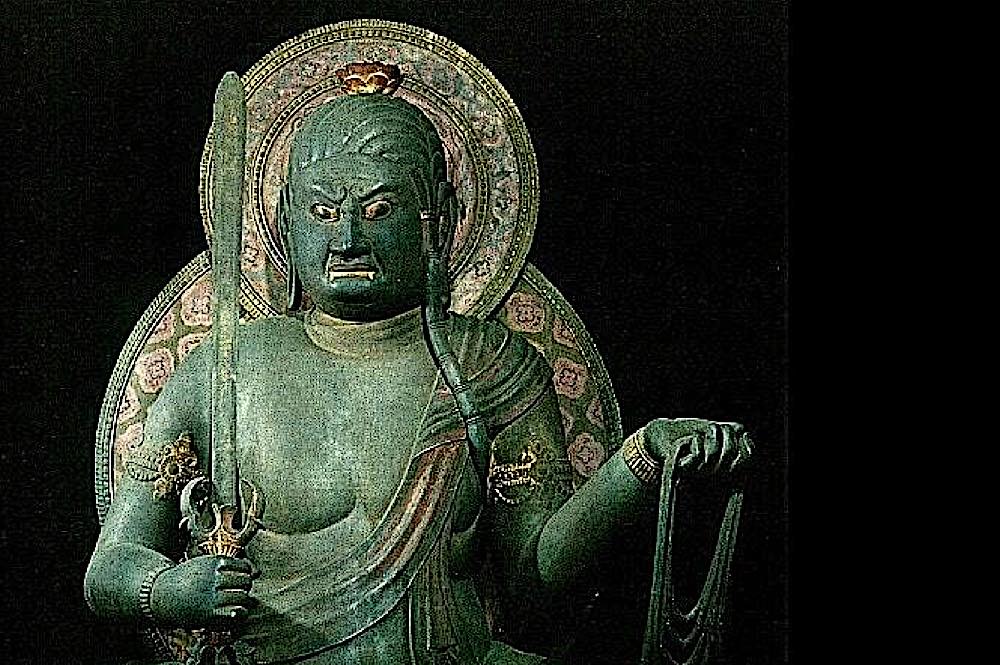 Famous statue of Achala Fudo Myoo, possibly carved by Kukai in Japan out of cypress wood.
Famous statue of Achala Fudo Myoo, possibly carved by Kukai in Japan out of cypress wood.
Why is an Enlightened One so warrior-like?
If he is an Enlightened One, why is he so warrior-like? He is chief among the Vidyarajas or Wisdom Kings. He is so stern and all-powerful that his full Sanskrit name, Arya Acalanatha, means “Noble Immovable Lord, ” indicating that nothing can shake his attention or power.
Fudo Myoo, or Achala in Sanskrit, is instantly recognizable by the classic blue-black body of wrath, the raised sword, and the ferocious face. He looks like a warrior who never rests, guarding the temple and our hearts and practicing with Enlightened wrathful compassion. Just like our stern parent protects us from harm as children, Achala is metaphorically ready to fight off our obstacles with his great Vajra sword.
Full Feature on Maha Vairocahana>>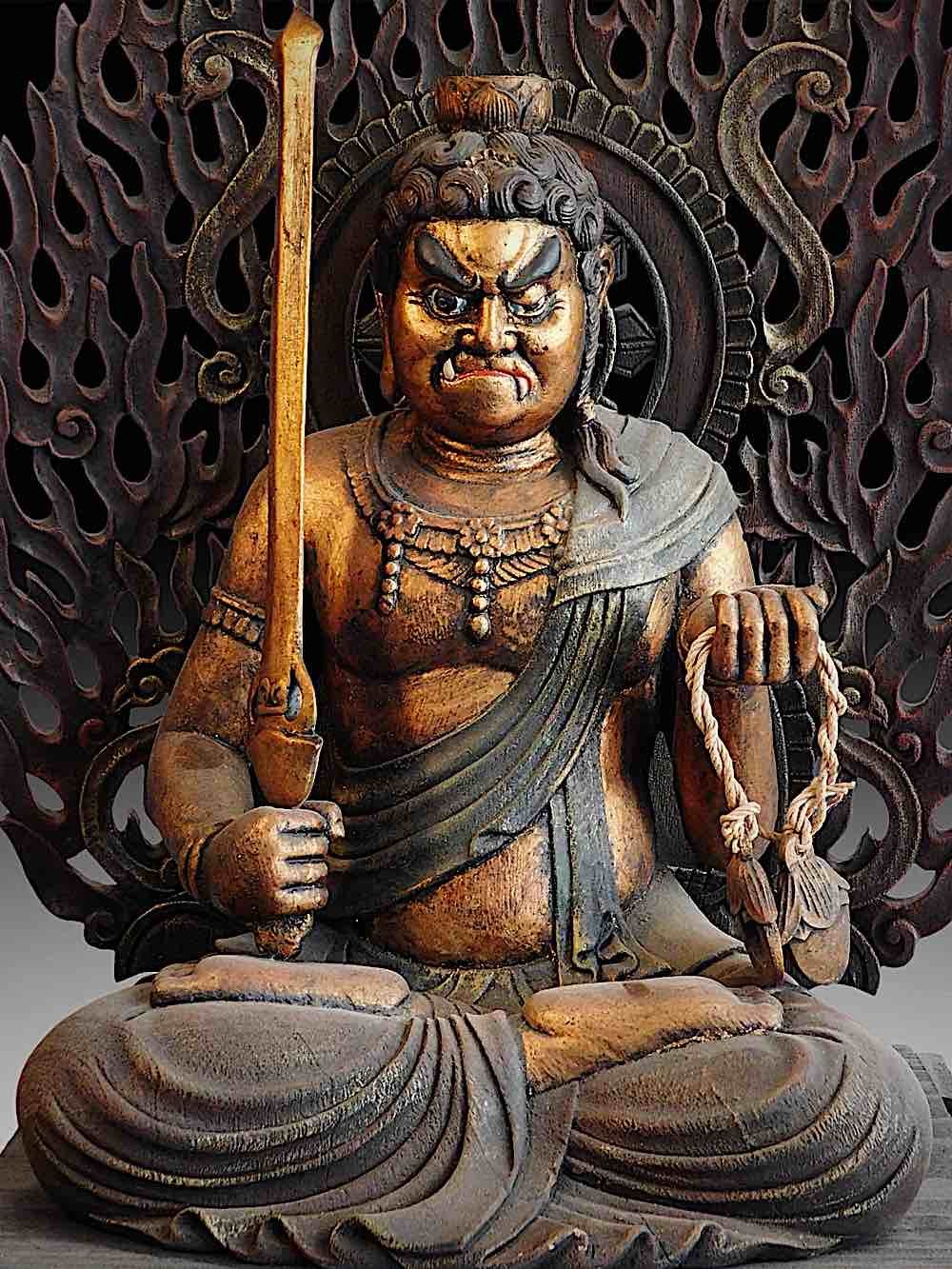 Full detail of very old Acala (Achala) statue.
Full detail of very old Acala (Achala) statue.
Fudo Myoo’s Symbolism
In the classical visualization, he has one fanged tooth protruding up from his snarling mouth and one down — indicating his wrathful activities are directed at all six realms of beings, below and above. Likewise, he often has one wrathful eye looking upwards and one looking downwards.
This is the type of warrior we need when facing difficulties, war, strife, poverty, illness, or suffering. Who do you go to for protection when you’re under attack from overwhelming evil-doers? The well-armed Dharma warrior who is heroically devoted to law and order and protection, or the kindly monk focused on mindful meditation? In those difficult times, the image of the warrior or policeman triggers the needed meditative response. We can certainly take refuge in the peaceful monk — but that great sword and wrathful face of Fudo Myoo inspires great confidence when facing challenging adversaries. He is especially reassuring in his form with a lotus crown on the top of his head, reminding us that he is fully Enlightened even though he is wrathful compassion.
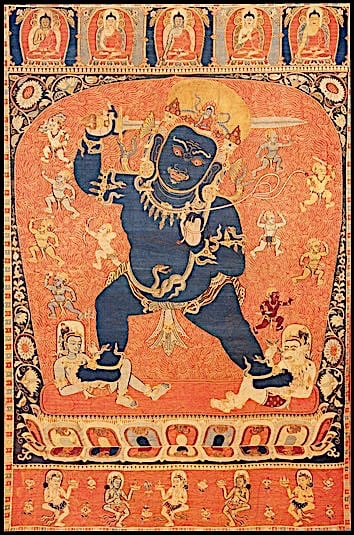 In Himalayan style art, based on different lineages, he can appear standing or kneeling on one knee, but he always as his sword in the right hand. Image Himalayan Art.org
In Himalayan style art, based on different lineages, he can appear standing or kneeling on one knee, but he always as his sword in the right hand. Image Himalayan Art.org
Countless Forms of Buddha
In Mahayana Buddhism, we visualize the Buddha in countless forms as part of the meditation on the Enlightened body, speech, and mind. The form we imagine is the Enlightened body, his mantra, and sutra are the Dharma or Enlightened speech, and the mind is the essence, represented symbolically by the seed syllable.
Every Buddha has a wrathful emanation form, a heroic form, and other forms. Maha Vairochana, the cosmic Adi Buddha, emanates in every Enlightened form according to the important Maha Vairochana Sutra. This particular wrathful emanation of Vairochana is Achala or Fudo Myoo.
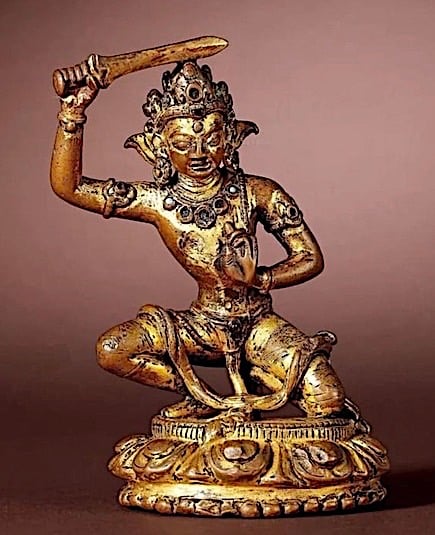 In this slightly different posture, Achala still holds the mighty sword, but is kneeling on one knee.
In this slightly different posture, Achala still holds the mighty sword, but is kneeling on one knee.
Maha Vairochana and Achala Together
They are almost always together in a temple, with Maha Vairochana as the center of attention, guarded by the wrathful Achala. In the cosmic mandala, Maha Vairochana is the mandala’s center, surrounded by the four Dhayani Buddhas. At the same time, Achala or Fudo Myoo is the center of the wrathful mandala, surrounded by the four wrathful aspects of the Dhyani Buddhas.
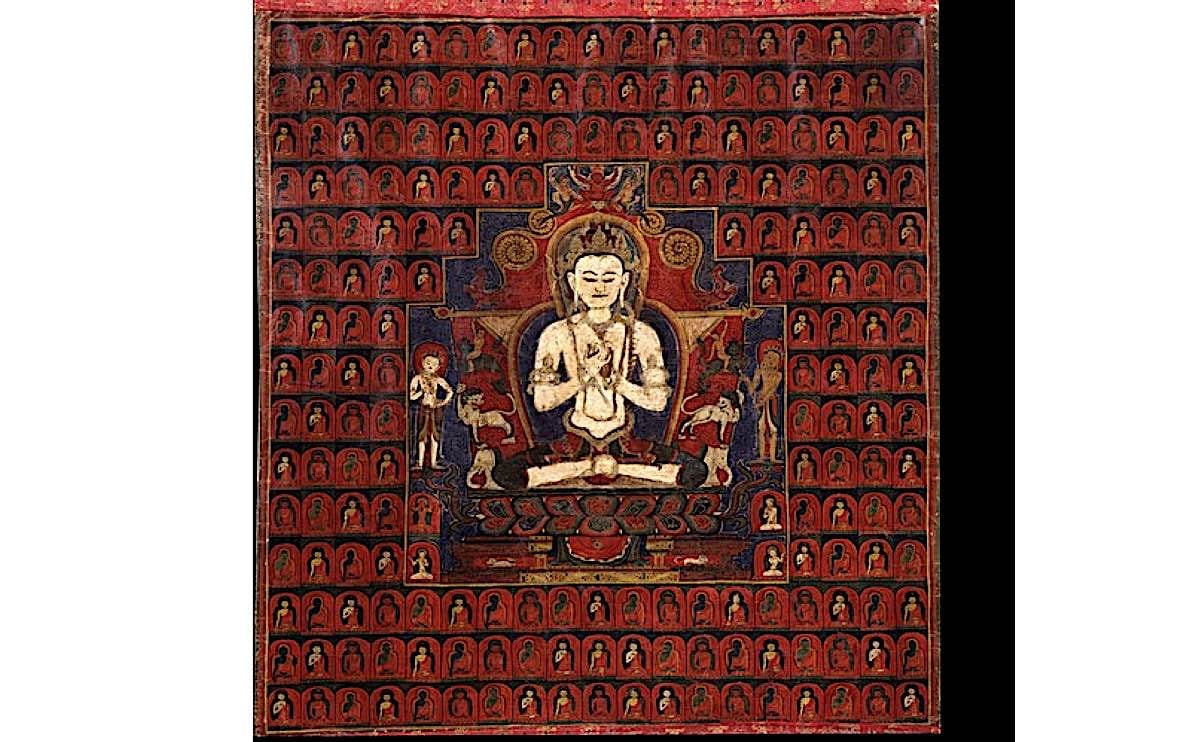 A very old thangka of Vairochana (note the Dharmachakra Wheel Turning Mudra of the hand gesture) surrounded by the 1000 Buddhas forms. In Sutra, he is said to emanate in 1000 froms — as Buddha in our wolrd — to 1000 worlds and dimensions — the Buddha of the entire Multiverse. See our written feature on Maha Vairochana here>>
A very old thangka of Vairochana (note the Dharmachakra Wheel Turning Mudra of the hand gesture) surrounded by the 1000 Buddhas forms. In Sutra, he is said to emanate in 1000 froms — as Buddha in our wolrd — to 1000 worlds and dimensions — the Buddha of the entire Multiverse. See our written feature on Maha Vairochana here>>Achala’s mantra is the Mantra of Compassionate Help to signify his Buddhist role. He is the activity of wrathful compassionate activity.
He is so vital he is seen as a manifestation of either Maha Vairochana, Akshobya, or Manjushri, depending on the lineages, although in the primary Sutras he is a manifestation of the great cosmic Buddha Maha Vairochana
 In Japan, because he is the center of the Womb Mandala, and also an emanation of Maha Vairochana, he is usually on a prominant shrine in most Shingon temples and many other tradition’s temples.
In Japan, because he is the center of the Womb Mandala, and also an emanation of Maha Vairochana, he is usually on a prominant shrine in most Shingon temples and many other tradition’s temples.
Maha Vairochana Sutra
The main lineages arise from the Maha Vairochana Sutra, but other emanations appear in lineage practices according to various Sarma traditions in Tibet. He was very popular in India in the 8th and 9th centuries, with 6 Sanskrit texts dedicated solely to his practice, translated by the master Amoghavajra. His practice spans Nepal, Tibet, China, Japan, and worldwide. In China, he is known as Bùdòng Míngwáng 不動明王 .
Achala’s seed syllable, or mind essence, is hāṃ, a syllable of wrathful power and respect. It is often confused with Hum, which looks similar and sounds similar. There is a “hum” in his mantra, but his seed syllable is the Ham.
 The Ham seed syllable of Achala Fudo Myoo. The seed syllable respresents the ultimate Dharmakaya aspect or essence of the Buddha. Many people confuse Hum and Ham due to similar sounds and look on paper, which are entirely different essences. Ham is a wrathful syllable of the compassion of all the Buddhas. It is an activity — or compassion in action.
The Ham seed syllable of Achala Fudo Myoo. The seed syllable respresents the ultimate Dharmakaya aspect or essence of the Buddha. Many people confuse Hum and Ham due to similar sounds and look on paper, which are entirely different essences. Ham is a wrathful syllable of the compassion of all the Buddhas. It is an activity — or compassion in action.
Achala’s Mantra in Sanskrit
He has several mantras, but his most important is called “The mantra of Compassionate Help,” reflecting the purpose of this wrathful and ferociously beautiful emanation of Maha Vairochana. This mantra is from the all-important Maha Vairochana Sutra, both in the long and short forms.
The lmantra of compassionate help is:
namaḥ samanta vajrā nāṃ caṇḍa-mahā roṣaṇa-sphoṭaya hūṃ traṭ hāṃ māṃ
नमः समन्तवज्राणां चण्डमहारोषणस्फोटय हूँ त्रट् हाँ माँ
In English, this translates, more or less, as:
Homage to the all-encompassing Vajra! O violent one of great wrath, destroy all obstacles, negativities, and evil!
Even though this is a reasonable translation, mantras should be chanted in Sanskrit, as seed syllables have layers of meaning, and sounds and vowels are sacred. For example, the seed syllable of Achala is Ham. Translating it as “violent one of great wrath” only carries one of the central aspects of the seed syllable.
There is also a shorter mantra of Achala or Fudo Myoo found in the Maha Vairocahana Sutra:
Namaḥ samanta vajrā nāṃ hāṃ
Which more or less translates as “Homage to the all-encompassing Vajra wrathful hero”. Here, we’re contextualizing Ham as “wrathful hero” to show that Ham has numerous meanings.
 Red Achala is a less common and esoteric practice.
Red Achala is a less common and esoteric practice.
Achala’s poses and consistent appearance
Although there are several poses and even different color aspects of Achala, he is consistently portrayed in all aspects with his vajra sword and usually his noose. He is always wrathful, fanged, and usually blue-black but has red and yellow aspects.
 Ki Fodo or Yellow Achala is another less common form, normally standing.
Ki Fodo or Yellow Achala is another less common form, normally standing.
In Japan, he is usually firmly seated or standing on a rock or stone to convey he is implacable and immovable in his wrathful compassion. Nothing can move him from his mission of protecting the Buddha Dharma.
In the Japanese visualization of Fudo, he usually has a lotus on his head as an ornament to signify compassion and Enlightenment. He is surrounded by a nimbus or halo of flames called Garuda Flames. His sword is a special one, called the three-pronged Vajra sword, or sanko ken, the most powerful of weapons. He can also be portrayed with the Dragon King sword, in which a naga appears coiled around the blade. This is the special sword of Dragon King Kurikara.
 Achala always has a sword in right hand, normally with three pointed vajra. He also often has heaven and earth eyes (one looks up one down.) Most representations also have the lasoo which hooks us with his compassionate activity.
Achala always has a sword in right hand, normally with three pointed vajra. He also often has heaven and earth eyes (one looks up one down.) Most representations also have the lasoo which hooks us with his compassionate activity.
Heaven and Earth Eyes
In Japan, he can be portrayed either with two fierce eyes or, more commonly, with “heaven and earth” eyes, which means one eye wide open and looking up toward heaven and the other narrowed and squinting down at earth. If he has heaven and earth eyes, he is usually portrayed with two fangs, one pointing up to heaven and one down toward earth. The up-pointing fangs symbolize his connection to the realm of the Purelands of the Buddhas, and the down-pointing fang symbolizes he also protects lower realms and sentient beings. They also represent yin and yang and male and female.
Achala contains the essence of all of these. He is wrathful and active in his compassionate help but called the Immovable one because of his implacable power over all realms. He has one eye on heaven and one on earth. His wrathful compassion, symbolized by the two teeth, embraces both the Buddha Realms and the Samsaric Realms.
Duality and Non-Duality Together
Why are Achala’s eyes important? The heaven and earth eyes derive again from the important Maha Vairochana Sutra and symbolize duality and non-duality — reflecting he is both dualistic and non-dualistic.
Although Fudo Myoo is blue or black, like deep space, in Japan, he also has aspects of Aka Fudo, which means Red Fudo, and Ki Fudo, who is yellow, although rare and esoteric.
Achala’s Many Attendants
Although Achala has an entourage of acolytes, usually with two, eight thirty-six, or forty-eight named, these represent the forces of nature. The two primary attendants, often seen serving him, are Kimkara and Chetaka. Kimkara is usually white, with his hands joined in respect. Chetaka is ordinarily red and holds a vajra in his left hand and a vajra staff in his right.
In South Asian Buddhist art, he can appear standing or kneeling on one knee, often with the sword raised as if to strike. In the Caṇḍamahāroṣaṇa Tantra, he is described this way:
His right hand is terrifying, with a sword in it,
His left is holding a noose;
He is making a threatening gesture with his index finger,
And bites his lower lip with his fangs.
Kicking with his right foot,
He is smashing the four Māras.
His left knee is on the ground.
Squint-eyed, he inspires fear.
He makes a threatening gesture at the Earth,
He is kneeling on the cap of his left knee.
He is of blue color and wears a jeweled headdress.
“A princely youth, Wearing Five Braids of Hair,
Adorned with all the ornaments,
He appears to be sixteen years old,
And his eyes are red—he, the powerful one.
The Go-To Practice for Obstacles
Whether we visualize Achala or Fudo Myoo in the exotic and beautiful Japanese form, or the Mara-tromping South Asian style, he is the go-to practice for people facing obstacles, negativities, war, disease or ripening negative karma. As the wrathful activity of the great Maha Vairochana, he brings the power of the Enlightened Cosmic Buddha into our lives.

 AbJimroe
AbJimroe 









